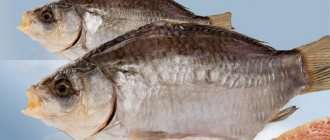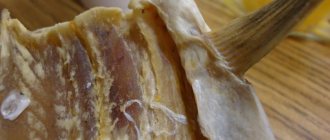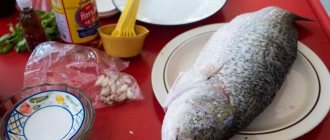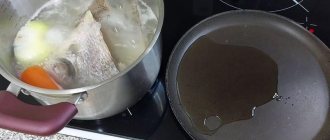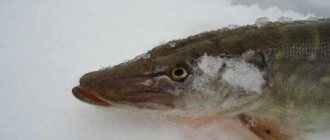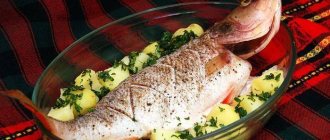Today, probably everyone knows that fish (river and especially sea fish) is a valuable and beneficial product for the body, a real storehouse of microelements and amino acids necessary for a person to function properly. It is no coincidence that people living in the coastal region have long been famous for their longevity and health - physical and mental. But at the same time, not every housewife or home cook has information on how to cut fish according to all the rules so that it retains its maximum benefits and at the same time gets rid of even small bones. In this article we will try to fill this gap.
Tools
Some people think that it is quite difficult to free these cold-blooded creatures from their bones, especially the small ones. But it's actually quite simple. Let's practice together, maybe a couple of fish will go away for training, but the third one will most likely be cleaned in an ideal way. But before you cut the fish, you still need to acquire the necessary tools. We will need:
- kitchen scissors for cutting fins;
- knife for removing scales;
- a sharp knife with a thin blade for separating the pulp from the bones;
- long board for cutting carcasses;
- tweezers (but you can do without them);
- and, of course, the fish itself.
With this minimum set you can begin to take action. By the way, regarding the paring knife: the simplest and most popular tool among people is a butter knife (with small teeth) or a vegetable knife (short). You can, undoubtedly, use modern technologies: fish scalers of various types, if you have them. But an ordinary potato knife will be quite enough.
How to cut fish: a detailed master class
- First, it is recommended that if the fish is fresh, rinse the carcasses in cool water under the tap. We carry out this simple procedure before cutting the fish in order to free it from excess mucus, dirt, algae (what if, you never know) and other elements we don’t need.
- The second step is to cut off the fins with kitchen scissors. Some sources indicate that this should be done after cleaning the fish from scales. But, most likely, this is not of fundamental importance; there is no global difference: before or after.
- We begin cleaning the carcass from scales. It is more convenient to clean from the tail, holding the fish itself with one hand, and with the other making short characteristic movements with a knife or a device for removing scales from the tail to the head.
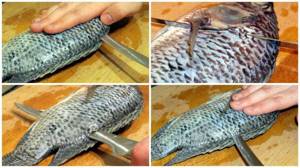
Where to dispose of fish waste
After cutting the fish, trimmings remain: head, spine, fins, tail, skin. Many people don't realize that these unsightly leftovers make a wonderful broth that can be used to make soup, aspic or sauce. To make a good broth, you will need very little, the actual fish trimmings and some vegetables and herbs for flavoring. Fish broth
- Place the leftover fish in a saucepan, add 2 liters of cold water and place over medium heat. Bring to a boil, reduce heat to low and skim off foam. Cut the onion, parsley root and carrots into 4-6 pieces and brown in a dry frying pan, this will give the broth additional taste and a pleasant color.
- Add vegetables, herbs, allspice and black peppercorns to the broth, pour in the wine and cook for 40 minutes, covering the pan with a lid. Remember, the broth should not boil too much, otherwise it will become cloudy.
- In 10 min. Before the end of cooking, add bay leaf and salt. Strain the finished broth.
- If you don't need the broth in the near future, cool it completely, then pour it into individual serving molds and freeze.
Several life hacks from experienced cleaners
- To prevent your fingers from slipping, you can periodically dip them in coarse kitchen salt.
- If you don’t want to collect scales all over the kitchen after cleaning, you can perform the scale cleaning procedure in a large plastic bag, putting the fish in it and putting your hands in it. This way you will get rid of the need for additional cleaning of the room.
- Before cleaning a small fish with small, nasty scales (for example, perch), you can pull the carcass by the tail quite strongly, holding the fish by the head with the other hand, as if stretching it. This way the scales will come off much easier.
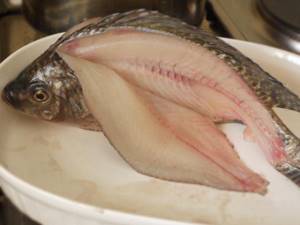
How to clean fish correctly
Of course, cleaning river and sea fish differs. Mainly due to the size of the scales. Marine is easier and faster to clean, as it is covered with small scales that quickly come off with physical impact. However, there are some rules you should know to make your job easier.
How to clear mucus
Some types of fish need to be cleared of their mucus layer before removing their scales. There are several options to solve this problem:
- Place the carcass in very hot water for 15–20 seconds. During this time, the mucus will disappear and you can begin cleaning.
- The second method is also quite simple. Before cleaning, rub the product with salt. The carcass stops sliding in your hands.
- When fishing, you can use sand instead of salt. But this method is not very convenient, because it is difficult to thoroughly wash the grains of sand from the meat later.
- For 3 l. dilute 1 tbsp of water. l. table vinegar. Place the carcasses into the solution for 1–2 minutes. Mucus is easily removed.
It's time to catch eels. We caught them and brought them home. The fish is interesting, but how to clean it from mucus? They brought the fish, put it in a bowl or any other dish and sprinkled the fish evenly with coarse salt. They let it stand for 20 minutes. Salt eats away mucus. All that remains is to rub a little with the remaining salt and rinse with water.
Wladimir
https://www.rybolov.de/poleznye_sowety/aal
I make it even simpler. Right when fishing, roll the fish in dry sand, wrap it tightly around the scruff of the neck with one hand, take it by the head with the other and stretch it out. And do this several times, it cleans great.
Neighbour
https://www.rybolov.de/poleznye_sowety/aal
You can also get rid of mucus not only on eels, but also on other fish using a vinegar solution.
Fossil
https://www.rybolov.de/poleznye_sowety/aal
The correct way to remove scales
Before you start cleaning, fill the sink, basin or any other container with water. We lower the carcass into the water. This will avoid unnecessary cleaning: the scales will not scatter throughout the kitchen, but will settle in the liquid.
- We cut off the fins so as not to get hurt by them when cleaning.
- We firmly grasp the fish by the head with one hand.
- In the other hand we take a fish scaler.
- We begin to clean from the tail towards the head, prying off the scales with a fish scaler.
- After cleaning, rinse the carcass under running water.
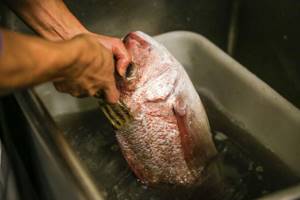
Place the fish in water and clean it with a fish scaler
Instead of a fish scaler, you can use a fishing knife, a sharp kitchen knife, a tablespoon or a fork. This method is perfect for various types: river and sea. However, with larger individuals you will have to put in more effort.
How to properly clean fish
Cleaning in quick ways
One of the most effective and fastest ways to clean fish from scales is to clean it with a grater. For this method we use a grater with 4 edges; it is more convenient to use.
- Place the fish on a work surface and press down with your hand. If the fish is small, you can pierce the tail with a fork or an awl, holding the tool and fixing the carcass.
- Let's take a grater. Using the side intended for preparing vegetable puree (with sharp teeth), we clean off the scales in the direction from the tail to the head.
- The scales at the base of the tail can be scraped off with the coarse side of a grater.
- We rinse the product under running water.
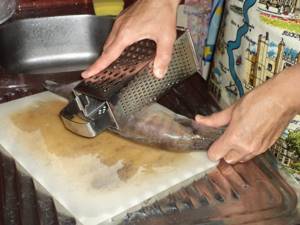
You can remove scales from fish using a grater.
In nature, instead of a grater, you can use a tin can, punching the bottom with nails. Pink salmon, chum salmon, pike perch and other species are cleaned this way. For individuals with hard scales, you can use the coarse edge of a grater.
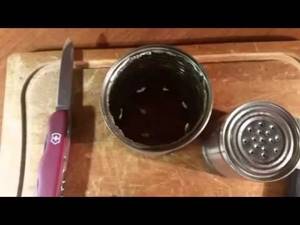
Instead of a grater, you can use a tin can, pierced with nails.
How to quickly peel fish with a grater
How to do it using... a drill
Traditional methods are often unusual, but nevertheless effective. We will tell you how to clean using a conventional drill:
- Prepare a clean container for the fish.
- We place the drill on a stool and secure it with tape.
- Insert a drill with a diameter of 10 mm into the drill.
- Turn on the tool, setting the mode to the minimum number of revolutions.
- Next to the stool we place a trash can or bag into which the scales will fall off.
- We take the carcass, holding it above the bucket, and place it under the drill.
- We clean off the scales in this way from the tail to the head.
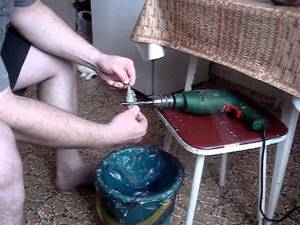
We move along the fish with a rotating drill
A drill is used to remove scales from river and sea specimens. It copes excellently with both small and large hard scales.
Cleaning video tip
Cleaning with KARCHER
This method of cleaning fish from scales is convenient outdoors, at the dacha or in the yard of a private house:
- Place the fish on a wooden work surface.
- To prevent the carcass from moving under the pressure of water, we fix it with self-tapping screws, placing caps from plastic bottles under the head of the screw. In this case, the lid acts as a washer, pressing the tail tightly against the board.
- We turn on the Karcher.
- Using a stream of water, knock off the scales in the direction from the tail to the head.
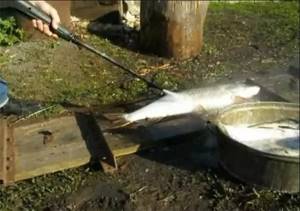
When cleaning with a Karcher, it is important to fix the fish
This method is convenient for cleaning large specimens. Small fish will not be able to withstand the pressure of the water and will fall off the clamp.
Cleaning scales with a Karcher
How to clean frozen
Many experts advise defrosting the fish before removing its scales. But most often there is not enough time to defrost. Is it possible to clean a carcass that has just been taken out of the freezer? It’s possible, because frozen products can be peeled quite easily.
- Cut off the fins.
- We cut off a strip of skin along with scales along the back and abdomen.
- Cut off the tail.
- We pry the skin with a knife at the base of the tail.
- Using a knife, remove the skin along with the scales in the direction from the tail to the head.
- We cut off the head, rip open the abdomen with a knife and remove the frozen entrails.
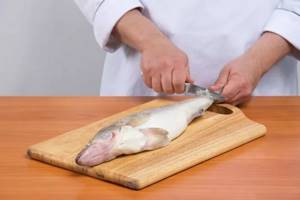
Using a knife, remove the skin along with the scales.
The method is perfect for small fish weighing up to 1.5 kg. It is better to defrost carcasses weighing more than 1.5 kg to avoid injury during cleaning and cutting. This method is used to remove scales from river species: crucian carp, perch, bream and others, as well as from sea fish, including salmon.
Video on processing frozen fish products
Evenki way of cleaning
In the north, this method is used all the time; it is convenient and easy to use:
- You can use any sharp knife.
- Holding the fish by the tail, place it vertically, resting its head on the work surface: board, stump, etc.
- We cut off the fins with sharp movements.
- We cut off its scales from the tail to the head in thin strips.

The scales are cut into thin strips
The method is interesting because even when cleaning fish with small scales, only the scales are cut off, not the skin. She remains untouched. In this way, in the north, all species that have been frozen are cleaned.
Cleaning fish from scales in Evenki style
How to gut?
Having made sure that the entire carcass is cleared of small scales (especially look closely near the tail), we proceed to gutting.
- How to properly cut fish, freeing it from the entrails? First, you should wash it thoroughly to remove any remaining scales.
- Place the carcass on a cutting board (we repeat, it should be narrow, but long enough for the fish to fit on it) with its head facing away from you.
- Holding the carcass with your hand, insert the end of the knife into the hole on the abdomen and make a longitudinal cut towards the head to its very base (the knife should not be immersed too deep so that the insides are not damaged or spread), dividing in half the bony part at the base of the lower jaw, located between the fish's fins (front).
- We remove the entrails by grabbing them with our fingers near the base of the fish's head. For squeamish housewives: you can use large tweezers for these purposes. We take out the entire intestine. Separate the liver and caviar, if available. Be sure to remove the film that covers the abdominal cavity so that it does not taste bitter when cooked.
Clean and gut
- The very first thing to do when cutting a fish is to remove its scales. To do this, it is convenient to use a special knife for cutting fish. But if you don’t have one, it’s okay - just take a knife with a short, strong blade. Start cleaning from the tail of the fish to the head. If the scales are attached to the fish too tightly, scald the carcass very quickly with boiling water. Once the scales are removed, rinse the fish with water.
- Now you need to remove the entrails from the belly of the fish - gut it. Make a long cut on the abdomen from the caudal fin to the head with a knife or scissors. The main thing when cutting fish is to carefully remove all the insides without damaging the gall bladder, which is located at the head next to the liver. If this does happen and very bitter bile spills onto the fish, remove all bile-stained parts of the fish, cut out and discard. You don’t want your dish to be distinctly bitter, do you? You need to remove the insides by pulling them out with your hand, grabbing them with a paper towel and helping yourself with a knife. Those insides that are attached to the head must be trimmed or pulled out with a strong movement.
- The internal cavity of the abdomen is covered with a film; it must be cut along the spine and removed. If there is any blood left on the fish's spine, remove it with a knife or your hands under a strong stream of water.
- If you need a whole fish for baking or a separate head for cooking soup, it’s time to start working on the gills; this must be done: the gills are bitter. It is convenient to remove them with kitchen scissors. Lift the gill covers and trim the gills at the top and bottom where they attach to the head, then pull them out. If you work without gloves, then handle the gills with a paper towel or rag: they are prickly.
- Use scissors to cut off the remaining fins on the tail, belly and head.
- Cut off the head of the fish perpendicular to the line of the abdomen, along the line of the gills. To cut off the head of a large fish, you will need a powerful knife.
- If before you only rinsed the fish, now you need to wash it very well. Do this in cold running water, thoroughly washing all surfaces to remove any remaining scales and entrails. At the same time, conduct a meticulous analysis for missed flaws. Then thoroughly wash the board to remove any remaining scales and entrails.
- If the fish is small, weighing 400-500 g, the resulting preparation will make an excellent portioned dish. If you plan to please your company with steaks, cut the fish into transverse pieces 2-3 cm thick.
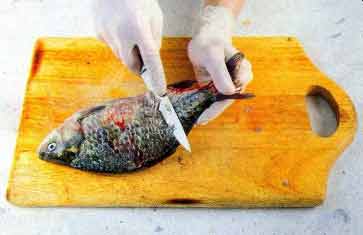
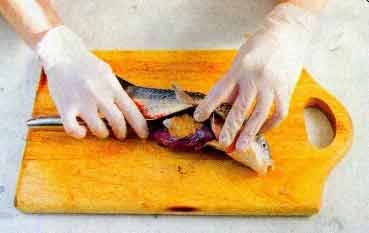

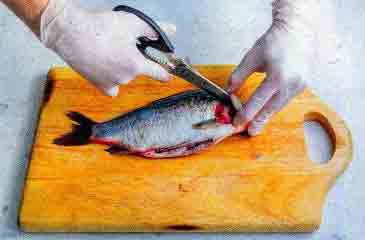
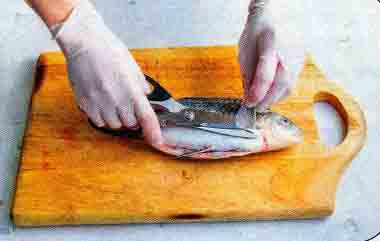
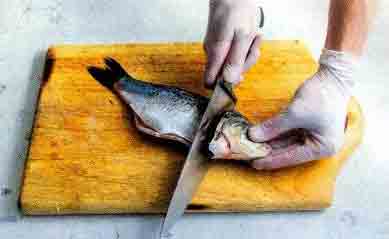
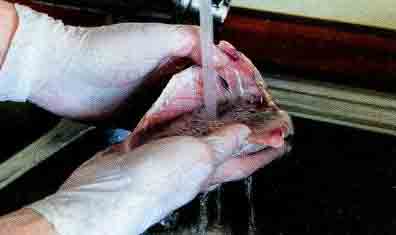
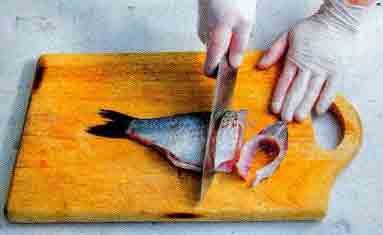
Head
What to do with a fish's head? The question is not an idle one. Before cutting the fish into fillets, this very head, of course, must be cut off at the very base. But if you are going to store a fresh carcass in the freezer or want to cook the entire inhabitant of the depths, that is, along with the head, then it will be extremely necessary to remove the gills. This is done using kitchen scissors. After everything, do not forget to thoroughly rinse the fish again before cooking it, preferably under running water.
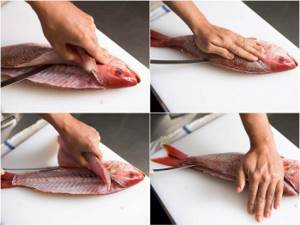
How to fillet fish correctly?
Some perceive such manipulations as the highest aerobatics of culinary art, but in fact there is nothing too complicated in the process - you only need a sharp knife and skills that are acquired through experience.
- So, as already mentioned, you need a special curved (fillet) knife. It's the easiest to use. But in extreme cases, a sharp, medium-length kitchen knife with a blade that is not too thick will do.
- Along the spine, we cut the carcass with one longitudinal cut from the head to the back. The blade should go along the bone, and not cut it (this can be felt tactilely), without much tension or effort.
- We begin to cut the fish lengthwise, deepening the cut so that the ribs are also captured. We repeat the same procedure on the other side of the spine, as if highlighting it (the knife works best at an angle of 45 degrees).
- We cut off the edge of the peritoneum along with the hypochondrium bones.
- Carefully probe the resulting fillet. If bones are found, take tweezers and pull them out. After which the fillet can be used for further cooking.
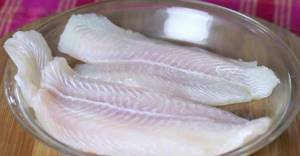
How to cut pollock after two fillets have been removed from the carcass?
Now it's the turn of the tweezers. If you don’t have a special fish tool on hand, you can use regular tweezers from a manicure set. Remove the long bones from the fillet by carefully prying and pulling them out using tweezers.
When it comes to skin removal, there are several options. If you plan to prepare minced fish, it is recommended to remove the skin. If you plan to cook steaks, then the skin must be left on. It is this that ultimately provides a crispy, appetizing, rosy piece.
How to cut pollock if you decide to remove the skin? The skin removal process takes just seconds. Gently pry the tip with your hand, pull it away from you, and move towards the tail. In some places the skin may not give in, so we help ourselves with a sharp knife. We perform the same manipulation with the second part of the carcass.
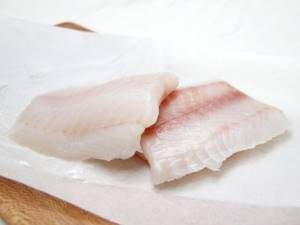
How to get fillet pieces?
This method is used to cut not only pollock, but also any other medium-sized fish. With a little skill and experience, the process will take no more than 10–15 minutes. Actions are carried out in stages.
- The fish is turned upward with its back and tail towards itself.
- Make a neat, even cut along the ridge, deepening the knife to the bones.
- Cut off one half of the carcass, drawing the blade with force along the ridge, but without touching it, while simultaneously cutting the rib bones. The direction of movement is from the abdomen to the tail. It is necessary to ensure that as little meat as possible remains on the spine of the fish.
- The other half of the fish is treated in the same way.
- The cut parts are turned with the inner surface up. All that remains is to separate the meat from the bones. This is done with a knife, catching them with the blade and removing them with your hands. Or use eyebrow tweezers, pulling out the ribs by the protruding tips in the back area.
- The most important step is separating the meat from the skin. If pollock is fried, it is better not to remove the skin - during the cooking process it will turn into a fragrant crispy crust. In other cases, the skin is caught at the edges where the head was cut off and pulled towards the tail. If in some places the skin does not separate well, then make shallow cuts with a knife.
Fillet of healthy and young pollock looks very appetizing. You can use it to cook juicy steaks, chopped cutlets, and make pasta with vegetables. Cutting fish at home allows you to save money that you have to spend on finished fillets. With proper processing, there is little waste left from pollock, and from the tails and heads you can cook aromatic fish soup with herbs
Advice from experts
- Before chopping, make sure your knives are thoroughly sharpened. If they are dull, you should sharpen them with improvised means. Otherwise, the blade will not cut, but tear the flesh.
- To remove or not to remove the skin is up to you. If you are going to fry fish in a frying pan or on the grill, then it is better not to do this: the skin will support the fillet so that it does not fall apart during cooking. If you are going to cook or stew, you can remove it. We do this by slightly cutting along the edge at the very base of the meat. Then, with careful movements, we pass along, tearing off gradually.
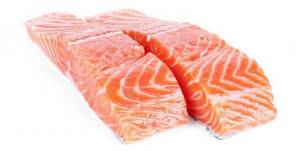
red fish
A few words about this beauty of the seas and rivers, which has recently become accessible and popular among the population. How to cut red fish - trout or salmon, for example? The algorithm of actions and tools are approximately the same, but there are some nuances. Today we will tell you how to fillet red fish (let it be salmon).
- We cut the head around the circumference in the area of the gill bone.
- We cut off the infra-caudal fin with scissors or a knife.
- From the inside along the spine (try in one movement) we separate the rib bones.
- We pull out the ridge, trying not to get hurt. To do this, you can hold the bone using toilet paper or a paper towel. It is more convenient to remove the remaining pulp from the ridge with a fork (then it can be used, for example, for rolls).
- We clean the future fillet from the spinal bones. We separate the ribs with a knife, then take out the smaller bones with tweezers and remove the skin with a sharp knife.
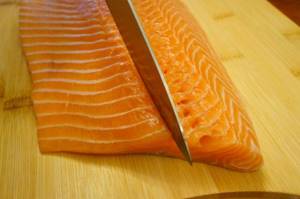
How to properly cut and salt fish. All the subtleties of this procedure to make it delicious
I always buy only frozen fish at the store. I avoid chilled and defrosted fish, as they like to write in stores, because this is a way to confuse a naive buyer. Everyone understands that the nearest sea is thousands of kilometers away from us, so fish can only reach us frozen. So it’s better to defrost it yourself, slowly, without haste and correctly.
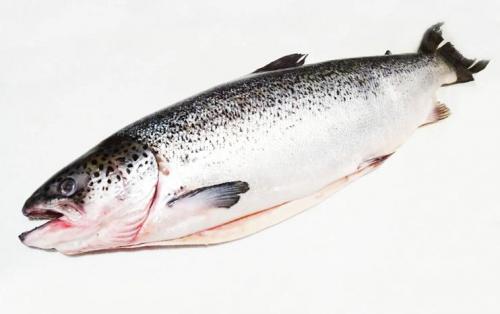
Before you start cutting fish, you need to sharpen the knife very well so that it is razor sharp. It should cut as soon as you touch it. From the very beginning to the very end. It also must be corrected with musat.
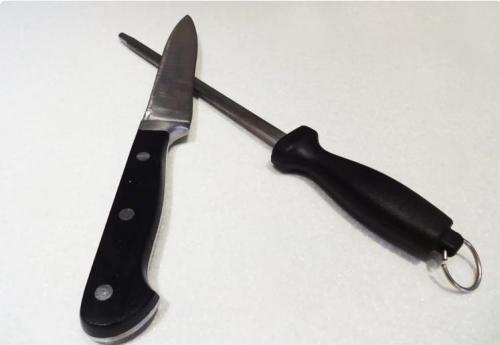
When the fish has become completely soft, you can begin the procedures. First of all, cut off her head. Do this at an angle and under the fin.
The head can be left on the ear. If it’s large, then it’s enough for two. I can usually then cook ours and overseas Bouillabaisse. I put it aside.
You can also save it for steaks; I’ll probably fry them right now. Of course, I’ll give a piece to my cat, who has already trampled on my feet and wiped them.
Next, turn the fish with its back towards you, place the knife slightly above the ridge and, pressing with one hand, remove the first fillet. Flip, rotate and repeat using the knife. Now you've removed the second one.
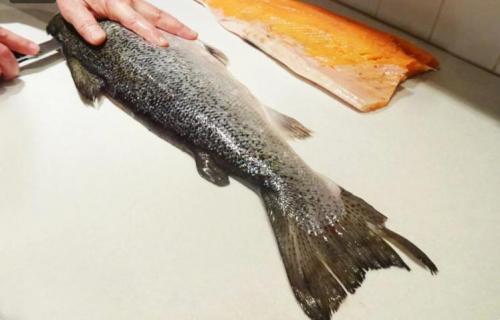
Set the backbone with the ribs, on which there is normal meat, to the head. For future fish soup. Cut off any bones that remain. Now take tweezers and use it to remove the small seeds. If they don’t come out well, then the fish is quite fresh.
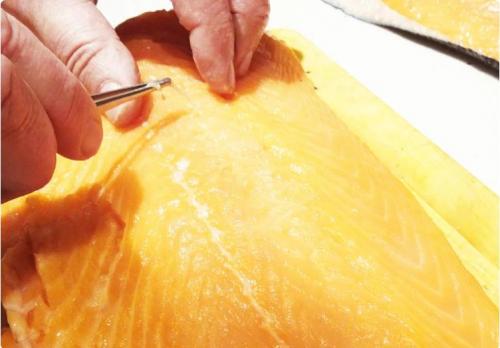
I cut my fish in half because it doesn’t fit anywhere. That is, I cut two fillets in half. I put the tails separately and the backs separately. I got almost 3 kg of fillet. The skin must not be removed, salt only with it! Without the skin, the fish won't taste right.

Let him lie still for now, because first you need to prepare the pickling mixture. You just need two products - salt and sugar, in proportions 2:1. Nothing more is needed. You can also add a teaspoon of brandy, but it will still be superfluous, because the fish is obviously delicious in itself.
I know some people still use dill. But for me it's a complete nightmare. If you want to turn salmon into herring, add dill. I ask you to never do that!
Sprinkle the ceramic mold with the mixture you received and place the first fillet, skin side down. Sprinkle the mixture over the next fillet again, skin side up. Mixture again. And again the fillet.
Cover with film and place on the bottom shelf of the refrigerator. Let it get salty. All that remains is to hold out for 24 hours so as not to try.
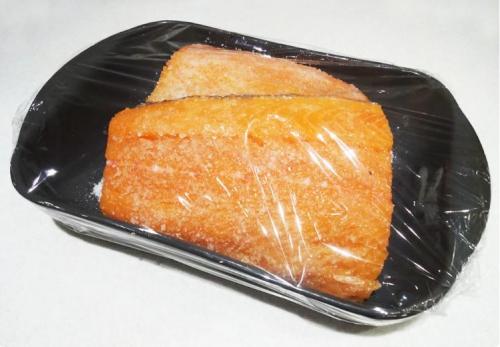
After 24 hours, rinse the remaining mixture on the fish, dry it and cut thin, larger pieces from the skin. Take one, crumple it up and quickly put it in your mouth. This is something amazing! Place the rest on a platter and place on the table. Make sure your family doesn't eat everything at once! Otherwise there will be nothing left for the New Year!
Who dreams about what?
And finally: do you know what it means if you had to cut fish in a dream, especially live fish? Such a dream is not entirely good, according to many modern and ancient dream books. It can mean an imminent loss of health (by you or loved ones), dissatisfaction with your position and appearance. And if a woman dreams of cutting up fish, then she will not give in to her hobbies and sympathies towards a man. But cleaning fish in a dream means quickly overcoming difficulties, and preparing it means material well-being.
